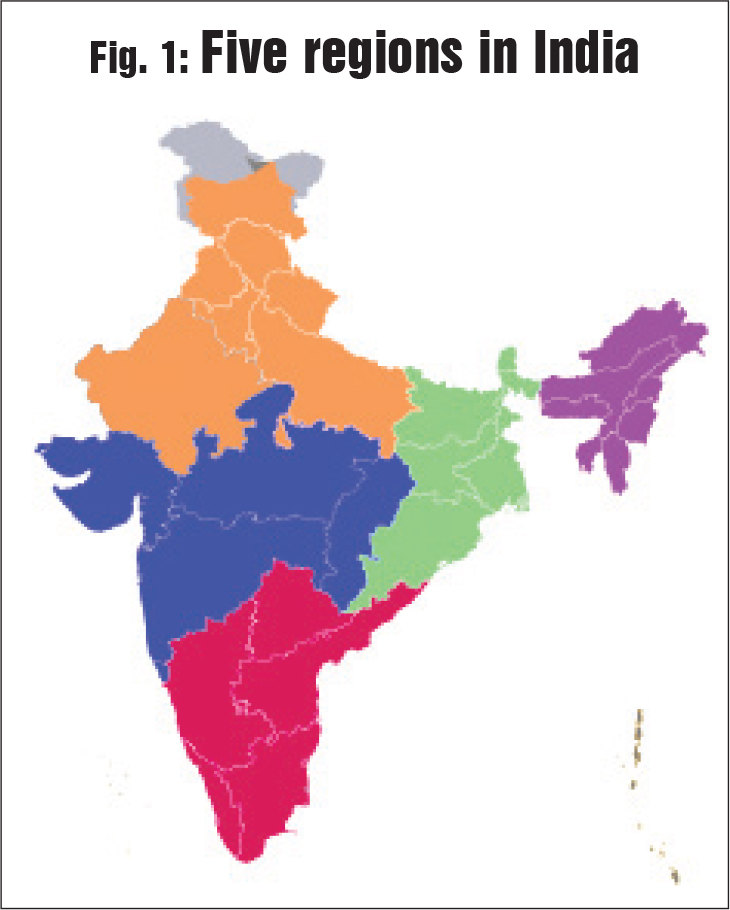
 By R.K. Choudhary, Member, and Raamish Tauseef, Deputy Director (Transmission), Bihar Electricity Regulatory Commission
By R.K. Choudhary, Member, and Raamish Tauseef, Deputy Director (Transmission), Bihar Electricity Regulatory Commission
India was initially divided into five regions – northern, eastern, western, north-eastern and southern – as depicted in Fig. 1.
The chronology of grid synchronisation in India is as follows:
- In October 1991, the north-eastern and eastern grids were connected through the 220 kV D/C line, connecting Birpara and Salakati.
- In March 2003, the western region (WR), eastern region (ER) and north-eastern region (NER) were interconnected through a 400 kV D/C line, from Rourkela to Raipur.
- In August 2006, by connecting Muzaffarpur and Gorakhpur through a 400 kV D/C line, the northern grid was connected to the ER-NER-WR grid constituting the NEW/central grid. Thus, four regional grids – northern, eastern, western and north-eastern – were synchronously connected, forming a central grid operating at one frequency.
- On December 31, 2013, with the commissioning of the 765 kV Raichur-Solapur transmission line, the isolated southern region was also connected to the rest of the central grid in synchronous mode, thereby achieving “one nation-one grid-one frequency” (see Fig. 2).
 This interconnection makes the Indian grid the biggest synchronised grid in the world with more than 228 GW of installed capacity. The focus has shifted from regional self-sufficiency to inter-regional links, which were planned with power generation projects so that beneficiaries of these projects would not be bound by regions. This synchronisation has come as a major relief to the power-deficit states of Tamil Nadu, Karnataka, Kerala and Andhra Pradesh. Synchronisation of the southern region grid with the rest of the country has not only improved power transfer among the regions, but has also minimised fluctuations in frequency. This success will pave the way for interconnection among other countries and the formation of a SAARC grid.
This interconnection makes the Indian grid the biggest synchronised grid in the world with more than 228 GW of installed capacity. The focus has shifted from regional self-sufficiency to inter-regional links, which were planned with power generation projects so that beneficiaries of these projects would not be bound by regions. This synchronisation has come as a major relief to the power-deficit states of Tamil Nadu, Karnataka, Kerala and Andhra Pradesh. Synchronisation of the southern region grid with the rest of the country has not only improved power transfer among the regions, but has also minimised fluctuations in frequency. This success will pave the way for interconnection among other countries and the formation of a SAARC grid.
The benefits of one nation-one grid-one frequency are summarised below:
- It reduces pressure on already scarce natural resources by transferring power from resource-centric regions to load-centric regions.
- It facilitate power trading across regions, thus establishing a vibrant electricity market.
- Increases grid reliability and stability with the synchronisation of large rotating inertial masses.
- Energy deficit at the national level improved continuously from 8.7 per cent in financial year 2012-13 to 0.4 per cent in financial year 2020-21. Meanwhile, the peak demand deficit improved from 9 per cent to 0.4 per cent.
It is noteworthy that power was a deficit commodity earlier, but in the present scenario it has become a surplus commodity. Therefore, it is now necessary to evolve a mechanism for optimisation of the cost of power to achieve a uniform cost of power across states by realising “one nation, one grid, one tariff”.
 The parliamentary standing committee also deliberated with all stakeholders including the CERC and SERCs in order to explore the feasibility and implementation of a uniform tariff across the country. Consequently, the Ministry of Power, Government of India, issued a discussion paper called Market-based Economic Despatch (MBED). The objective of the discussion paper is to create a merit order at the national level through suitable scheduling and despatch of all contracts among beneficiaries and generators.
The parliamentary standing committee also deliberated with all stakeholders including the CERC and SERCs in order to explore the feasibility and implementation of a uniform tariff across the country. Consequently, the Ministry of Power, Government of India, issued a discussion paper called Market-based Economic Despatch (MBED). The objective of the discussion paper is to create a merit order at the national level through suitable scheduling and despatch of all contracts among beneficiaries and generators.
The MBED envisages ex-bus uniformity of the generation cost based on the variable cost of the plant. However, in order to get a near-uniform retail tariff across states, it is very important to obtain a uniform overall landed cost of power at the state periphery, including interstate transmission charges and losses.
Uniformity of retail tariff
The broad components of the retail tariff for consumers are depicted in Fig. 3.
It is evident that the intra-state generation cost, the intra-state transmission cost and the distribution cost are state specific and come under the concurrent list of the constitution. Thus, there is scope for uniformity in the power procurement cost in the remaining two components – interstate generation cost and interstate transmission cost. A major component affecting the retail tariff is the power purchase cost (interstate generation cost plus interstate transmission charges and losses), which normally lies in the range of 70-80 per cent of the average cost of supply (ACS) for most of the states.
This paper lays emphasis on merit order despatch based on the variable cost of interstate generation and corresponding interstate transmission charges and losses so that the landed cost at the state periphery is uniform.
However, most of the long-term power purchase agreements (PPAs) signed between discoms and generators have a two-part tariff, comprising a fixed cost (FC) and a variable cost. Variable cost optimisation at ex-bus has been covered under the MBED discussion paper, but the effect of FC, which is a major component of the power procurement cost that varies from PPA to PPA and also depends on the useful life of the generating stations, has not been elaborated upon with respect to achieving a uniform power procurement cost across the states. So, after adding the FC component to the landed cost of power, that is, the variable cost of interstate generation and transmission charges and losses, it is very likely that the overall cost of power to the discoms at the state periphery may vary owing to the differential cost of the FC component.
Even after factoring in the above-mentioned components for achieving uniformity of power purchase cost at the state periphery, making retail tariffs uniform for all the states may not be feasible for the following reasons:
- State-specific policies
- Geographical area
- Population
- Consumer mix, etc.
Therefore, if as a first step the landed cost of power including interstate transmission charges and losses are the same for all states, it would provide a more realistic opportunity to utilities to move towards a “near-uniform tariff” as tariff variations will be restricted to 20-30 per cent of ACS (intra-state generation cost, intra-state transmission cost and distribution cost). These variations can be further minimised after interaction among all the states.
 As an illustration, it can be observed that at present the national average power purchase cost (APPC) and the APPC of eastern states have wide variations (see table).
As an illustration, it can be observed that at present the national average power purchase cost (APPC) and the APPC of eastern states have wide variations (see table).
It can be concluded from Table 1 that:
- The APPC of Bihar is more than that of other constituents in the same region.
- The APPC of Bihar is more than the national APPC.
- In Odisha, the APPC is lower owing to its own large quantity of intra-state hydropower generation. The APPC of other states needs to be analysed further.
- The above APPC is the aggregate of interstate and intra-state generation costs, which need to be segregated to determine the interstate APPC only.
 The way forward
The way forward
- As the first step, ex-bus power purchase cost for interstate generation may be made uniform across the state as proposed in the MBED.
- The interstate transmission charges should also be made uniform based on unit handled (Rs per kWh), which is the simplest way, although it may not be in the spirit of the Tariff Policy, which states that transmission pricing should be based on distance, direction and quantum of power.
- The interstate generation cost and interstate transmission cost should be made uniform for all states. However, only 70-80 per cent of the ACS will be made uniform. The issue pertaining to fixed cost under a bilateral contract may be dealt with as follows:
- Scrap all existing PPAs, which is not feasible in the current scenario.
- As the majority of the long-term PPAs are likely to expire in approximately 10 years, allow the existing PPAs to operate till the expiry of the contract.
- After the expiry of the contract, no such long-term bilateral PPAs should be allowed and all transactions should be done through the exchange.
- Now, only 20-30 per cent of the ACS (intra-state generation cost, intra-state transmission cost and distribution cost) needs to be optimised further so that a near-uniform tariff can be achieved across the country.
(Note: The opinions expressed in this article are those of the authors and do not reflect the opinions of BERC or its members.)
